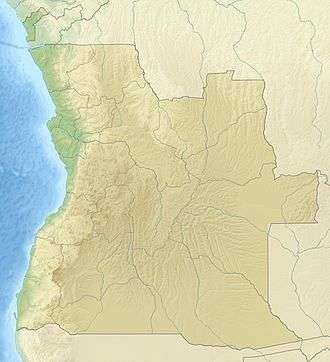Cambambe Hydroelectric Power Station
The Cambambe Hydroelectric Power Station is a hydroelectric power plant across the Kwanza River at the border between Cuanza Norte Province and Bengo Province in Angola. Following rehabilitation and expansion, the generation capacity of this installation is 960 megawatts (1,290,000 hp).[1]
| Cambambe Power Station | |
|---|---|
 Location of Cambambe Power Station in Angola | |
| Country | Angola |
| Location | Cuanza Norte Province |
| Coordinates | 09°45′12″S 14°28′51″E |
| Status | Under construction |
| Construction began | 7 October 1959 |
| Opening date | 6 October 1963 |
| Dam and spillways | |
| Type of dam | Arch dam |
| Impounds | Kwanza River |
| Height (thalweg) | 132 m (433 ft) |
| Length | 300 m (980 ft) |
| Spillways | 7 |
| Spillway capacity | 4,500 m3/s (160,000 cu ft/s) |
| Reservoir | |
| Surface area | 5.5 km2 (2.1 sq mi) |
| Turbines | Cambambe 1: 4 x 65 MW, Francis-type Cambambe 2: 4 x 175 MW Francis-type |
| Installed capacity | Cambambe 1: 260 MW Cambambe 2: 700 MW Total: 960 MW |
| Website ahcambambe | |
Location
The power station is located across the Kwanza River, in Cambambe, Angola, about 198 kilometres (123 mi), by road, southeast of Luanda, the capital and largest city in the country.[2] The geographical coordinates of the power station are:09°45'12.0"S, 14°28'51.0"E (Latitude:-9.753333; Longitude:14.480833).[3]
Overview
The construction of Cambambe 1 Dam was started on October 7, 1959 and finished in 1963.[4] Due to wear and tear as well as lack of maintenance, by 2002, output had fallen from 180 megawatts to approximately 80 megawatts.[1]
In April 2007, a consortium comprising Odebrecht, Voith, Alstom and Engevix, was hired by the Empresa Nacional de Electricidade, to carry out the project of rehabilitation, expansion and modernization of the dam and power station. The project includes the heightening of the structure by 30 meters, the modernization of the generating units of the Cambambe 1, replacing the four 45 MW turbines by four 65 MW turbines, and the construction of a new plant, called Cambambe 2, with four generating units of 175 MW each, for a total of 700 MW. The works in Cambambe 1 started in March, 2009 and in Cambambe 2 in 2013.[1]
Construction
In July 2015, it was anticipated that the first 175 megawatts turbine of Cambambe II, would be installed and come online in June 2016, with completion expected in 2017.[5]
Other upgrades included the construction of three new energy transformation substations, with capacities 400KV, 220KV and 60KV, to support connection between Cambambe 1 and 2, Capanda Hydroelectric Power Station and Laúca Hydroelectric Power Station. The renovation and upgrade of Cambambe 1 and the construction of Cambambe 2, cost an estimated US$2 billion.[5]
The completed power station was commissioned on 27 July 2017, in front of 500 invited guests.[6]
See also
References
- Patric Kiehlmann (2010). "The expansion of the Cambambe Hydropower Plant in Africa". Heidenheim an der Brenz, Germany: Voith.com. Retrieved 20 June 2020.
- Google (20 June 2020). "Road Distance Between Luanda, Angola and Cambambe Hydroelectric Power Station, Angola" (Map). Google Maps. Google. Retrieved 20 June 2020.
- Google (20 June 2020). "Location of Cambambe Hydroelectric Power Station" (Map). Google Maps. Google. Retrieved 20 June 2020.
- Macauhub (30 June 2016). "Plant II of the Cambambe dam in Angola goes into operation" (Archived from the original on 8 July 2016). Macauhub.com.mo. Retrieved 20 June 2020.
- Angola Press News Agency (30 July 2015). "Cuanza Norte: Second Cambambe dam plant to start in June 2016" (Translated from the original Portuguese language). Luanda: Angola Press News Agency. Retrieved 20 June 2020.
- Water Power Magazine (27 July 2017). "Cambambe 2 opens in Angola". Dartford, Kent, United Kingdom: Waterpowermagazine.com. Retrieved 20 June 2020.